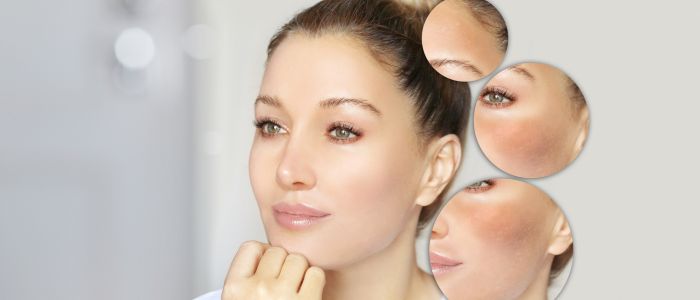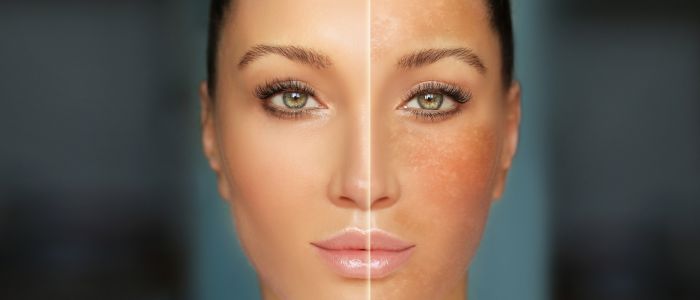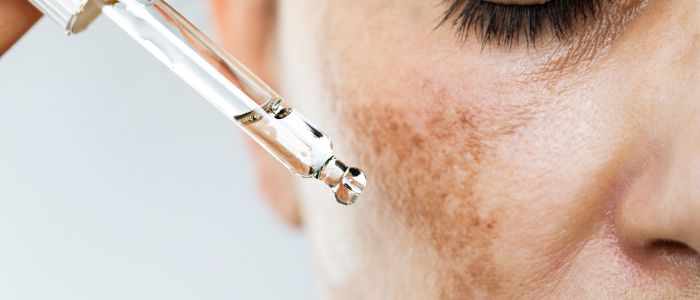
Table of Contents
- Solutions for Melasma
- What is Melasma?
- What are the Causes of Melasma?
- How to Recognise Melasma
- Types of Melasma
- Diagnosing Melasma
- Melasma – Prevention Strategies
- Treatment Options for Melasma
- Topical Treatments for Melasma
- Chemical Peels
- Microdermabrasion
- Laser and Light Therapies
- Oral Medications
- Combination Therapies
- Lifestyle Changes and Home Care for Melasma
- When to Seek Professional Help for Melasma
- FAQs about Causes and Treatment for Melasma
- Further Reading about Procedures at Cheshire Cosmetic Surgery
Solutions for Melasma
Melasma is a common skin condition that affects millions of people worldwide, causing dark, discoloured patches on the face. If you’re struggling with this frustrating skin issue, you’re not alone. As a dermatologist with years of experience treating melasma, Dr Dalia can provide you with valuable insights into melasma causes, prevention, and treatment options.
What is Melasma?
Melasma, often referred to as the “mask of pregnancy,” is a skin condition characterised by brown or greyish-brown patches typically appearing on the face. These patches are most commonly found on the cheeks, forehead, nose bridge, and upper lip. While it can affect anyone, melasma is particularly prevalent among women, especially those with darker skin tones.
The condition is caused by an overproduction of melanin, the pigment responsible for skin colour. This excess melanin is deposited in the upper layers of the skin, resulting in the characteristic dark patches. While melasma isn’t harmful to your health, it can significantly impact your appearance.
What are the Causes of Melasma?
Here are the primary factors that contribute to the development of this skin condition:
- Hormonal Changes: One of the most significant triggers for melasma is hormonal fluctuation. This explains why the condition is often associated with pregnancy, birth control pills, and hormone replacement therapy. During pregnancy, the increase in oestrogen, progesterone, and melanocyte-stimulating hormone can lead to hyperpigmentation.
- Sun Exposure: Ultraviolet (UV) radiation from the sun is a major culprit in the development and exacerbation of melasma. UV light stimulates melanocytes, the cells responsible for producing melanin, leading to increased pigmentation in susceptible individuals.
- Genetic Predisposition: If you have a family history of melasma, you may be more likely to develop the condition. Genetic factors can influence your skin’s susceptibility to hyperpigmentation.
- Certain Medications: Some medications, including those used to treat thyroid disorders and certain anti-seizure drugs, can increase your risk of developing melasma.
- Cosmetic Products: Certain skincare products or cosmetics may irritate your skin, potentially triggering or worsening melasma in some individuals.
- Stress: While not a direct cause, stress can exacerbate hormonal imbalances and potentially worsen melasma symptoms.
- Heat and Infrared Light: Recent studies suggest that heat and infrared light may also play a role in melasma development by stimulating melanocytes.
How to Recognise Melasma
Melasma can sometimes be confused with other skin conditions, so it’s essential to know what to look for. The hallmark signs of melasma include:
- Symmetrical brown or greyish-brown patches on the face
- Most commonly affected areas: cheeks, forehead, upper lip, and nose bridge
- Patches that darken with sun exposure
- Smooth skin texture (unlike some other pigmentation disorders)
If you notice these symptoms, it’s advisable to consult Dr Dalia for a diagnosis.
Types of Melasma
Melasma can be categorised into three types based on the depth of pigment in the skin:
- Epidermal Melasma: This is the most superficial type, affecting the top layer of skin. It appears as light brown patches with a well-defined border and responds well to treatment.
- Dermal Melasma: This type affects the deeper layers of skin and appears as bluish-grey patches. It’s more challenging to treat than epidermal melasma.
- Mixed Melasma: As the name suggests, this type combines both epidermal and dermal melasma, featuring both light brown and bluish-grey patches.
Diagnosing Melasma
Diagnosing melasma accurately is crucial for effective treatment. Dr Dalia uses different methods to ensure a precise diagnosis and rule out other skin conditions that may present similarly.
The first step in diagnosing melasma is a thorough visual examination. Dr Dalia carefully inspects the affected areas, noting the colour, distribution, and symmetry of the pigmentation. Melasma typically presents as symmetrical brown or greyish-brown patches on sun-exposed areas of the face, particularly the cheeks, forehead, upper lip, and nose bridge.
Dr Dalia also conducts a detailed patient history, asking about factors such as sun exposure, hormonal changes, family history, and medication use. This information helps identify potential triggers and contributes to a more accurate diagnosis.
To further confirm the diagnosis and determine the depth of pigmentation, Dr Dalia might use a Wood’s lamp examination. This special ultraviolet light allows me to distinguish between epidermal and dermal melasma, which can influence treatment choices.
In some cases, Dr Dalia may employ dermoscopy, a non-invasive technique that uses a handheld device to examine the skin more closely. This can help differentiate melasma from other pigmentary disorders like post-inflammatory hyperpigmentation or lichen planus pigmentosus.
While rare, a skin biopsy may be necessary if the diagnosis remains uncertain. This involves taking a small sample of skin for microscopic examination.
It’s important to note that melasma can sometimes be confused with other conditions such as post-inflammatory hyperpigmentation, sunspots, or certain types of skin cancer. Therefore, a professional diagnosis is crucial.
Melasma – Prevention Strategies
While not all cases of melasma can be prevented, there are several steps you can take to reduce your risk or minimise its severity:
- Sun Protection: This is the foundation of melasma prevention. Use a broad-spectrum sunscreen with an SPF of at least 30 daily, even on cloudy days. Reapply every two hours, especially if you’re outdoors. Consider using physical sunscreens containing zinc oxide or titanium dioxide for added protection.
- Wear Protective Clothing: Hats, long-sleeved shirts, and sunglasses can provide additional protection against harmful UV rays.
- Avoid Peak Sun Hours: Try to limit your sun exposure, especially between 10 am and 4 pm when the sun’s rays are strongest.
- Be Cautious with Hormonal Treatments: If you’re using birth control pills or hormone replacement therapy, discuss potential skin-related side effects with your doctor.
- Choose Gentle Skincare Products: Opt for non-irritating, fragrance-free skincare products to minimise skin irritation that could trigger melasma.
- Manage Stress: Incorporate stress-reduction techniques into your daily routine, such as meditation, yoga, or regular exercise.
Treatment Options for Melasma
While melasma can be stubborn, there are numerous treatment options available. The most effective approach often involves a combination of therapies tailored to your specific case. Here are some of the treatments we offer at our clinic:
Topical Treatments for Melasma
- Hydroquinone: This is a powerful skin-lightening agent that inhibits melanin production. It’s available in both over-the-counter and prescription-strength formulations.
- Tretinoin: A vitamin A derivative that promotes cell turnover and can help fade dark patches.
- Corticosteroids: These can help reduce inflammation and lighten the skin when used in combination with other treatments.
- Kojic Acid: A natural skin-lightening agent derived from fungi.
- Azelaic Acid: This ingredient has anti-inflammatory and skin-lightening properties.
- Vitamin C: A potent antioxidant that can help brighten the skin and protect against further damage.
Chemical Peels
These treatments involve applying a chemical solution to the skin to remove the top layers, promoting cell turnover and reducing pigmentation. Common peels for melasma include glycolic acid, salicylic acid, and trichloroacetic acid (TCA) peels.
Microdermabrasion
This technique uses tiny crystals to gently exfoliate the skin, removing dead cells and promoting collagen production. It can be effective for epidermal melasma when combined with other treatments.
Laser and Light Therapies
- Fractional Laser Treatment: This targets specific areas of the skin, promoting collagen production and reducing pigmentation.
- Intense Pulsed Light (IPL): This broad-spectrum light treatment can help reduce pigmentation and improve overall skin tone.
- Low-Fluence Q-Switched Nd:YAG Laser: This is particularly effective for dermal melasma.
Oral Medications
In some cases, oral treatments such as tranexamic acid may be prescribed to help manage melasma from within.
Combination Therapies
Often, a combination of treatments yields the best results. For example, we might combine topical treatments with periodic chemical peels or laser therapy for optimal outcomes.
It’s important to note that melasma treatment requires patience and consistency. Results are not immediate, and it may take several weeks or months to see significant improvement. Moreover, maintenance treatments are often necessary to prevent recurrence.
Lifestyle Changes and Home Care for Melasma
In addition to professional treatments, there are several things you can do at home to manage your melasma:
- Consistent Sun Protection: We can’t stress this enough – daily sun protection is crucial. Use a broad-spectrum sunscreen every day, rain or shine.
- Gentle Skincare Routine: Use a mild cleanser and avoid harsh scrubs or exfoliants that can irritate the skin.
- Stay Hydrated: Proper hydration is essential for overall skin health. Drink plenty of water and use a good moisturiser.
- Healthy Diet: Consume a balanced diet rich in antioxidants, which can help protect your skin from damage.
- Avoid Heat Exposure: Try to stay cool, as heat can exacerbate melasma in some individuals.
- Be Patient and Consistent: Stick to your treatment plan and don’t get discouraged if you don’t see immediate results.
When to Seek Professional Help for Melasma
While some cases of melasma may improve with over-the-counter treatments and lifestyle changes, it’s advisable to consult a dermatologist if:
- Your melasma is severe or widespread
- Over-the-counter treatments haven’t been effective
- You’re unsure if what you’re experiencing is melasma
- Your melasma is causing significant distress or affecting your quality of life
At Cheshire Cosmetic Surgery, Dr Dalia offers comprehensive evaluations to determine the best course of treatment for your individual case. Schedule a consultation today for diagnosis and treatment for melasma.
FAQs about Causes and Treatment for Melasma

Can men develop melasma, or is it exclusively a women’s condition?
While melasma is more common in women, men can indeed develop this condition. Male melisma accounts for about 10% of all melasma cases. In men, it’s often linked to sun exposure and genetics rather than hormonal factors.
Is melasma contagious?
No, melasma is not contagious at all. It’s a condition that occurs due to internal factors like hormones and genetics, as well as external factors like sun exposure. You cannot ‘catch’ melasma from someone else or spread it to others through contact.
Can certain foods or dietary changes help improve melasma?
While there’s no specific diet proven to cure melasma, some foods may help support overall skin health. Antioxidant-rich foods like berries, leafy greens, and fish high in omega-3 fatty acids may help protect your skin from damage. Some studies suggest that foods rich in folic acid, like leafy greens and citrus fruits, might help with pigmentation issues. However, diet alone is not a substitute for medical treatment.
Is it safe to use makeup to cover melasma?
Yes, it’s generally safe to use makeup to cover melasma. In fact, Dr Dalia often recommends using cosmetics with added sun protection as an additional defence against UV rays. Look for non-comedogenic, fragrance-free products to minimise skin irritation. Mineral-based makeup can be particularly good as it often includes natural sun-blocking ingredients like zinc oxide or titanium dioxide.
Can melasma disappear on its own after pregnancy?
In many cases, pregnancy-induced melasma (also known as chloasma) can fade on its own within a few months after delivery or once you stop breastfeeding. However, this isn’t guaranteed for everyone. Some women may find that their melasma persists and requires treatment. Continued sun protection is essential during this time to prevent the condition from worsening or becoming more permanent.
Medical References for Melasma
- Azelaic Acid Versus Hydroquinone for Managing Patients With Melasma: https://pubmed.ncbi.nlm.nih.gov/19213228/
- The Low-Fluence Q-Switched Nd:YAG Laser Treatment for Melasma: https://pubmed.ncbi.nlm.nih.gov/16635652/
- Most worthwhile superficial chemical peel for melasma of skin of color: Authors’ experience of glycolic, trichloroacetic acid, and lactic peel: https://pubmed.ncbi.nlm.nih.gov/12472344/
- Treatment of melasma using kojic acid in a gel containing hydroquinone and glycolic acid: https://pubmed.ncbi.nlm.nih.gov/17645377/
- The combination of glycolic acid peels with a topical regimen in the treatment of melasma in dark-skinned patients: a comparative study: https://pubmed.ncbi.nlm.nih.gov/10568135/
Further Reading about Procedures at Cheshire Cosmetic Surgery
- Read more about What Causes Spots on Cheeks?
- Read more about How to Treat Marionette Lines
- Read more about What Does Skin Cancer Look Like?
- Read more about Dermal Filler Clinic in Chester
- Read more about Where to Get Skin Relaxing Injections in Chester
- Read more about Causes and Treatment for Urticaria
- Read more about Causes and Treatment for Post-inflammatory Hyperpigmentation








